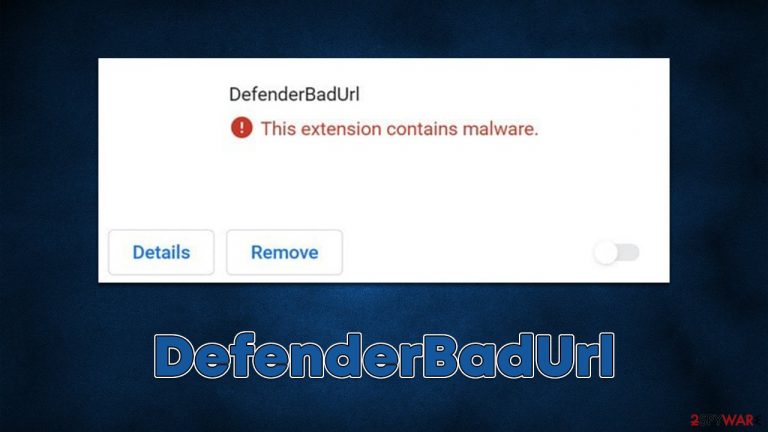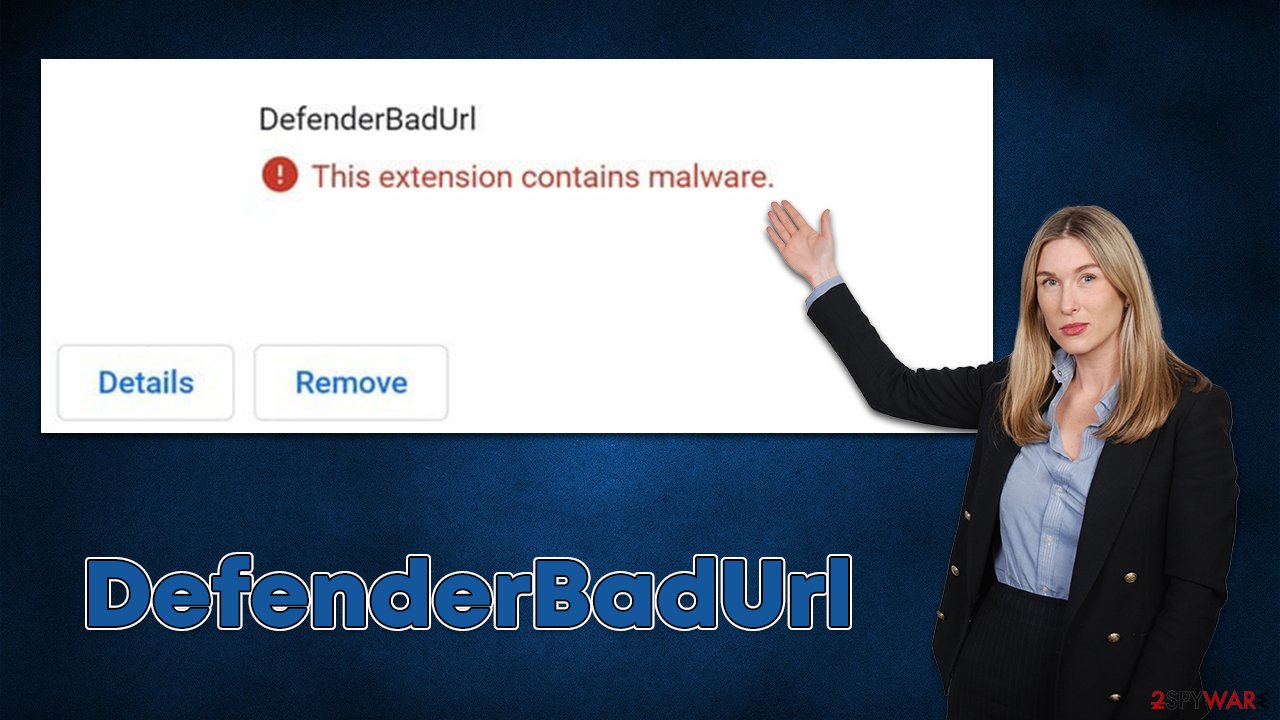DefenderBadUrl browser extension (Free Guide)
DefenderBadUrl browser extension Removal Guide
What is DefenderBadUrl browser extension?
DefenderBadUrl is a malicious browser extension that runs intrusive ad campaigns once installed

DefenderBadUrl is a browser extension that you might find on your Google Chrome or another compatible browser one day, seemingly out of nowhere. This usually happens due to deceptive distribution tactics used by its authors – software bundling[1] or misleading ads are commonly used for that purpose, which makes people install the app unintentionally.
Initially, the extension promises users to protect them from potentially dangerous and malicious websites while browsing the web. However, as soon as it gets installed on the browser, not only does it fail to do so by instead delivering intrusive pop-ups, banners, auto-play, in-text, and similar advertisements during users' web browsing sessions.
Upon installation, the app asks for permission to read and change all data on all websites, which allows intensive data tracking capabilities. It goes without saying that such functionality can seriously compromise users' privacy, as the information might not be adequately protected or even sold/shared to unknown parties.
Due to these deceptive operation and distribution methods, DefenderBadUrl is categorized as adware – software that primarily focuses on displaying ads and gaining revenue in the process. What it means is that its initial functionality (which is allegedly protecting from malicious websites) is hardly functional, making the app completely useless and sometimes even dangerous. Hence, we provide detailed instructions on how to remove it below.
| Name | DefenderBadUrl |
|---|---|
| Type | Adware, potentially unwanted program |
| Distribution | Software bundles, although deceptive ads can also be used |
| Symptoms | Unknown extension or application is installed on the system; ads appear on most websites; |
| Risks | You might be tricked into installing insecure software or pay for useless services; privacy issues might also arise due to information gathering practices |
| Removal | To get rid of unwanted apps manually, you can follow our removal guide below. If the unwanted ads and other disruptive behavior does not stop, you should scan your computer with SpyHunter 5Combo Cleaner security software and delete all threats automatically |
| Further steps | After you eliminate all PUPs from your system, make sure you clean your web browsers and repair system files. You can do that automatically with FortectIntego or refer to our manual guide |
Distribution and avoidance
As we have already mentioned, potentially unwanted applications are usually installed behind users' backs thanks to various phishing[2] and social engineering tricks. However, it is important to note that none of the adware, browser hijackers, or other PUPs are distributed in the same way as true malware (Trojans, ransomware,[3] rootkits, keyloggers, etc.) is. Thus, people believing that adware somehow magically shows up on their devices are wrong, and it can be easily explained.
First of all, let's talk about software bundling – a distribution technique that applies to most potentially unwanted programs, DefenderBadUrl included. While it is not malicious per se, its incorrect implementation can arguably be just that, as the distributors commonly hide certain elements within the installation wizards on purpose to make users install optional apps.
One of the most common tactics used is luring users with “Recommended” or “Quick” settings. This is where most people make a mistake because they believe it is the fastest and most efficient way of installing the desired program. However, by choosing this option, you might automatically agree to install optional components, thus you should never do it. Instead, always select the “Advanced” or “Custom” setting when possible – it will provide you with more control over the installation.
Likewise, you should never rush through steps by pressing the “Next” button several times, read the fine print, and always examine the buttons you are clicking thoroughly (you might click “Accept offer” if not being careful) and untick all the optional applications on the way.
The second common delivery method for the DefenderBadUrl virus is through misleading advertisements. Quite often, users might encounter a fake ad claiming system errors or viruses found on their devices, and the promised software should be downloaded. Fake Flash Player updates are also very common – the plugin has been discontinued by Adobe for a while now, and all the requests to install or update it are fake.

1. Remove the extension and check for other malware
The presence of DefenderBadUrl, especially if not installed intentionally, might not always be detected immediately. What users mostly notice are the ads that seem to appear on almost all websites they browse. Also, those infected with adware are more likely to encounter various phishing messages or scams, such as “You need to update your browser to view the content” or “Trojan Spyware Alert – Error Code: #0x564897.”
Generally, if you see various suspicious websites and an increased number of ads, you should never ignore these symptoms. The culprit of this behavior might be DefenderBadUrl or another malicious application that could be harvesting your personal information or performing other dangerous tasks on your device.
The first thing you should do is find and uninstall all the unwanted or suspicious extensions from your browser. Keep in mind that some seemingly trustworthy add-ons might start misbehaving abruptly, thus, if you are not sure which one is causing the symptoms, simply get rid of them all.
Google Chrome
- Open Google Chrome, click on the Menu (three vertical dots at the top-right corner) and select More tools > Extensions.
- In the newly opened window, you will see all the installed extensions. Uninstall all the suspicious plugins that might be related to the unwanted program by clicking Remove.

Mozilla Firefox
- Open Mozilla Firefox browser and click on the Menu (three horizontal lines at the window's top-right).
- Select Add-ons.
- In here, select the unwanted plugin and click Remove.

MS Edge (Chromium)
- Open Edge and click select Settings > Extensions.
- Delete unwanted extensions by clicking Remove.

MS Edge (legacy)
- Select Menu (three horizontal dots at the top-right of the browser window) and pick Extensions.
- From the list, pick the extension and click on the Gear icon.
- Click on Uninstall at the bottom.

Safari
- Click Safari > Preferences…
- In the new window, pick Extensions.
- Select the unwanted extension and select Uninstall.

Adware can also be installed on the system level, which could potentially be much more dangerous than a browser extension. Such programs can create new scheduled tasks or run malicious processes in the background but never display an active window, which makes detecting them much more difficult for regular computer users.
Therefore, we strongly recommend you perform a full system scan with powerful anti-malware software, such as SpyHunter 5Combo Cleaner or Malwarebytes. By scanning your machine, you would ensure that the most aggressive adware and dangerous malware are eliminated at once. To finish the DefenderBadUrl removal process, you should always clean your browsers.
2. Clean your browsers
As we already mentioned, adware is known for its data collection capabilities and often records users' IP addresses, visited websites, search queries, links clicked, and similar details. Some, more aggressive adware or malware, can also gather passwords, banking details, and other sensitive information.
Therefore, cleaning web browsers from cookies, caches, and other web data is a mandatory process that should be done by everybody who completed the MinePass removal. You can employ FortectIntego to make this process quicker (the tool can also repair damaged system components after malware infections and fix various PC issues automatically) or refer to the manual steps below.
Google Chrome
- Click on Menu and pick Settings.
- Under Privacy and security, select Clear browsing data.
- Select Browsing history, Cookies and other site data, as well as Cached images and files.
- Click Clear data.

Mozilla Firefox
- Click Menu and pick Options.
- Go to Privacy & Security section.
- Scroll down to locate Cookies and Site Data.
- Click on Clear Data…
- Select Cookies and Site Data, as well as Cached Web Content, and press Clear.

MS Edge (Chromium)
- Click on Menu and go to Settings.
- Select Privacy and services.
- Under Clear browsing data, pick Choose what to clear.
- Under Time range, pick All time.
- Select Clear now.

MS Edge (legacy)
- Click on the Menu (three horizontal dots at the top-right of the browser window) and select Privacy & security.
- Under Clear browsing data, pick Choose what to clear.
- Select everything (apart from passwords, although you might want to include Media licenses as well, if applicable) and click on Clear.

Safari
- Click Safari > Clear History…
- From the drop-down menu under Clear, pick all history.
- Confirm with Clear History.

How to prevent from getting adware
Choose a proper web browser and improve your safety with a VPN tool
Online spying has got momentum in recent years and people are getting more and more interested in how to protect their privacy online. One of the basic means to add a layer of security – choose the most private and secure web browser. Although web browsers can't grant full privacy protection and security, some of them are much better at sandboxing, HTTPS upgrading, active content blocking, tracking blocking, phishing protection, and similar privacy-oriented features. However, if you want true anonymity, we suggest you employ a powerful Private Internet Access VPN – it can encrypt all the traffic that comes and goes out of your computer, preventing tracking completely.
Lost your files? Use data recovery software
While some files located on any computer are replaceable or useless, others can be extremely valuable. Family photos, work documents, school projects – these are types of files that we don't want to lose. Unfortunately, there are many ways how unexpected data loss can occur: power cuts, Blue Screen of Death errors, hardware failures, crypto-malware attack, or even accidental deletion.
To ensure that all the files remain intact, you should prepare regular data backups. You can choose cloud-based or physical copies you could restore from later in case of a disaster. If your backups were lost as well or you never bothered to prepare any, Data Recovery Pro can be your only hope to retrieve your invaluable files.
- ^ Bundled Software. Techopedia. Professional IT insight.
- ^ What Is Phishing?. Proofpoint. Glossary.
- ^ Ransomware. Wikipedia. The free encyclopedia.
